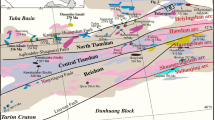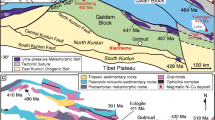Abstract
The Shitoukengde Cu-Ni deposit is located in the eastern part of the East Kunlun Orogenic Belt (EKOB). The overall complex underwent emplacement into the surrounding rock, including the gneiss and marble. The ore-bodies exist in complex I, which is composed of peridotite, pyroxenite, and gabbro. The petrogeochemical characteristics of the rocks show that the m/f values range from 1.93 to 5.97, and the Fe3+/ΣFe ratios of the spinel are < 0.3, indicating that the Shitoukengde complexes have the potential to form a Cu-Ni ore deposit. Based on the evidence of marble and gneiss xenoliths, there are higher CaO and Al2O3 contents in the peridotite and pyroxene, there are Nb and Ta depletions, in the Shitoukengde; these results indicate that the ore-forming parental magma has been obviously contaminated by crustal material during the evolution process and that the materials responsible for the contamination mainly originated from the middle-upper crust. The mafic-ultramafic complex, which is closed to marble, has higher CaO and Al2O3 contents; higher (87Sr/86Sr)i values and lower Ni contents; thus, it is reasonable to infer that the Shitoukengde mafic-ultramafic rocks assimilated some marble, and the contamination of marble without sulfide suppresses the sulfide saturation. The pyroxenite with better mineralization is mainly orthopyroxene, and the increase in the sulfur isotope values in the pyroxenite and peridotite is accompanied by an increase in the Ni content; these results suggest that the SiO2 and S of biotite-plagioclase gneisses, especially the S addition, were important for the Shitoukengde intrusion to reach sulfide saturation. The whole-rock Ni content in the peridotite shows a positive relationship with the FeO content of spinel, indicating that the crystallization of spinel has little effect on sulfide saturation. The capable of crystallizing olivine with Fo content as high as 89.3 mol% and olivine Fo value exhibits a positive relationship with the olivine NiO content, indicating that olivine fractional crystallization did not play a significant role in sulfide saturation. The δ34SV-CDT value of the giant Xiarihamu deposit is much higher than that of Shitoukengde. The degree of crustal S contamination is probably responsible for the difference in the scale and ore grade of the Cu-Ni sulfide deposits in the East Kunlun area. The above indicators could guide the exploration and evaluation of similar deposits in the EKOB.
Similar content being viewed by others
References
Baker, J.A., Menzies, M.A., Thirlwall, M.F., and Macpherson, C.G., 1997, Petrogenesis of Quaternary intraplate volcanism, Sana’a, Yemen: implications for plume-lithosphere interaction and polybaric melt hybridization. Journal of Petrology, 38, 1359–1390.
Duan, X., Meng, F., and Fan, Y., 2017, Comparison of Shitoukengde and Xiarihamu mafic-ultramafic in East Kunlun. 16th Annual Academic Conference of the Chinese Society of Mineralogy, Petrology and Geochemistry (Abstract), Xi’an, Apr. 18–21, p. 333–334. (in Chinese)
Feng, C., Zhao, Y., Li, D., Liu, J., and Liu, C., 2016, Mineralogical characteristics of the Xiarihamu nickel deposit in the Qiman Tagh Mountain, East Kunlun, China. Geological Review, 62, 215–228. (in Chinese with English abstract)
Frei, D., Liebscher, A., Van, K.P.M., Wunder, B., and Blundy, J., 2012, Trace element partitioning between orthopyroxene and anhydrous silicate melt on the lherzolite solidus from 1.1 to 3.2 GPa and 1,230 to 1,535°C in the model system Na2O-CaO-MgO-Al2O3-SiO2. Contributions to Mineralogy and Petrology, 157, 473–490.
Gan, C., 2014, Petrology, geochemistry, U-Pb dating and Hf isotopic composition of zircons in igneous rocks from East Kunlun orogen, Qinghai. M.Sc. Thesis, University of Geosciences, Beijing, 214 p. (in Chinese with English abstract)
Gao, X. and Thiemens, M.H., 1993, Variations of the isotopic composition of sulfur in enstatite and ordinary chondrites. Geochimica et Cosmochimica Acta, 57, 3171–3176.
Griffin, W.L., Pearson, N.J., Belousova, E.A., Jackson, S.E., Van Achterbergh, E., O’Reilly, S.Y., and Shee, S.R., 2000, The Hf isotope composition of cratonic mantle: LAM-MC-ICPMS analysis of zircon megacrysts in kimberlites. Geochimica et Cosmochimica Acta, 64, 133–147.
He, D., 2016, Tectonic evolution of the Precambrian metamorphicrock in East Kunlun orogenic belt. Ph.D. Thesis, Northwest University, Xi’an, 137 p. (in Chinese with English abstract)
Jiang, C.Y., Lin, J.L., and Zhou, W., 2015, Petrogenesis of the Xiarihamu Ni-bearing layered mafic-ultramafic intrusion, East Kunlun: implications for its extensional island arc environment. Acta Petrologica Sinica, 31, 1117–1136. (in Chinese with English abstract)
Labidi, J., Cartigny, P., and Moreira, M., 2013, Non-chondritic sulphur isotope composition of the terrestrial mantle. Nature, 501, 208–211.
Li, C., Ripley, E.M., Thakurta, J., Stifter, E.C., and Liang, Q., 2013, Variations of olivine Fo-Ni contents and highly chalcophile element abundances in arc ultramafic cumulates, southern Alaska. Chemical Geology, 351, 15–28.
Li, C., Zhang, Z.W., Li, W.Y., Wang, Y.L., and Sun, T., 2015, Geochronology, petrology and Hf-S isotope geochemistry of the newly-discovered Xiarihamu magmatic Ni-Cu sulfide deposit in the Qinghai-Tibet plateau, western China. Lithos, 216, 224–240.
Li, L., Sun, F.Y., Li, B.L., and Li, S.J., 2018, Geochronology, geochemistry and Sr-Nd-Pb-Hf isotopes of No. I complex from the Shitoukengde Ni-Cu sulfide deposit in the eastern Kunlun Orogen, Western China: implications for the magmatic source, geodynamic setting and genesis. Acta Geologica Sinica (English Edition), 92, 106–126.
Li, S.J., Sun, F.Y., Gao, Y.W., Zhao, J.W., Li, L.S., and Yang, Q., 2012, The theoretical guidance and the practice of small intrusions forming large deposits — the enlightenment and significance for searching breakthrough of Cu-Ni sulfide deposit in Xiarihamu, East Kunlun, Qinghai. Northwestern Geology, 45, 185–191. (in Chinese with English abstract)
Li, W.Y., 2018, The primary discussion on the relationship between Paleo-Asian Ocean and Paleo-Tethys Ocean. Acta Petrologica Sinica, 34, 2201–2210. (in Chinese with English abstract)
Lightfoot, P.C. and Hawkesworth, C.J., 1997, Flood basalts and magmatic Ni, Cu, and PGE sulphide mineralization: comparative geochemistry of the Noril’sk (Siberian Traps) and West Greenland sequences. Geophysical Monograph Series, 100, 357–380.
Ling, J.Y., Zhao, Y.F., Kang, Z., Jiang, C.Y., Song, Z.B., Zhao, S.X., and Wang, Y.G., 2014, Petrogenesis and mineralization of Niubiziliang mafic-ultramafic intrusion in the northern margin of Qaidam Block, NW China. Acta Petrologica Sinica, 30, 1628–1646. (in Chinese with English abstract)
Liu, Y.G., Chen, Z.G., Xu, X.H., Kou, X., Zhang, Z.W., Liu, F., Wang, Y.L., and You, M.X., 2019b, The Cu-Ni mineralization potential of the Kaimuqi mafic-ultramafic complex and the indicators for the magmatic Cu-Ni sulfide deposit exploration in the East Kunlun orogenic belt, northern Qinghai-Tibet Plateau, China. Journal of Geochemical Exploration, 198, 41–53.
Liu, Y.G., Li, W.Y., Jia, Q.Z., Zhang, Z.W., Wang, Y.L., and You, M.X., 2018, The dynamic sulfide saturation process and a possible slab break-off model for the giant Xiarihamu magmatic nickel ore deposit in the East Kunlun orogenic belt, northern Qinghai-Tibet Plateau, China. Economic Geology, 113, 1383–1417.
Liu, Y.G., Li, W.Y., Lü, X.B., Liu, Y.R., Ruan, B.X., and Liu, X., 2017, Sulfide saturation mechanism of the Poyi magmatic Cu-Ni sulfide deposit in Beishan, Xinjiang, Northwest China. Ore Geology Reviews, 91, 419–431.
Liu, Y.G., Lü, X.B., Ruan, B.X., Liu, X., Liu, S., and Feng, J., 2019a, A comprehensive information exploration model for magmatic Cu-Ni sulfide deposits in Beishan, Xinjiang. Mineral Deposits, 38, 644–666. (in Chinese with English abstract)
Liu, Y.G., Lü, X.B., Yang, L.H., Wang, H., Meng, Y.F., Yi, Q., Zhang, B., Wu, J.L., and Ma, J., 2015, Metallogeny of the poyi magmatic Cu-Ni deposit: revelation from the contrast of PGE and olivine composition with other Cu-Ni sulfide deposits in the Early Permian, Xinjiang, China. Geosciences Journal, 19, 613–620.
Macdonald, R., Rogers, N.W., Fitton, J.G., Black, S., and Smith, M., 2001, Plume-lithosphere interactions in the generation of the basalts of the Kenya Rift, East Africa. Journal of Petrology, 42, 877–900.
Mollo, S., Gaeta, M., Freda, C., and Misiti, V., 2010, Carbonate assimilation in magmas: a reappraisal based on experimental petrology. Lithos, 114, 503–514.
Naldrett, A.J., 2004, Magmatic Sulfide Deposits: Geology, Geochemistry and exploration. Springer Science & Business Media, Berlin, 728 p.
Park, Y.R., 2004, Stable isotopic constraints on Fluid-Rock interaction and Cu-PGE-S redistribution in the Sonju Lake Intrusion, Minnesota. Economic Geology, 99, 325–338.
Pearce, J.A., Stern, R.J., Bloomer, S.H., and Fryer, P., 2013, Geochemical mapping of the Mariana arc-basin system: implications for the nature and distribution of subduction components. Geochemistry, Geophysics, Geosystems, 6, 406–407.
Qian, B., Zhang, Z.W., Zhang, Z.B., and Ji, S., 2015, Ziron U-Pb geochronology of Niubiziliang mafic-ultramafic intrusion on the northwest margin of Qaidam Basin Qinghai. Chinese Geology, 42, 482–493. (in Chinese with English abstract)
Ripley, E.M. and Li, C., 2013, Sulfide saturation in mafic magmas: is external sulfur required for magmatic Ni-Cu-(PGE) ore genesis? Economic Geology, 108, 45–58.
Song, X.Y., Yi, J.N., Chen, L.M., She, Y.W., and Wu, S.K., 2016, The giant Xiarihamu Ni-Co sulfide deposit in the East Kunlun orogenic belt, northern Tibet Plateau, China. Economic Geology, 111, 29–55.
Wang, G., 2014, Metallogenesis of nickel deposits in Eastern Kunlun orogenic belt, Qinghai Province. Ph.D. Thesis, Jilin University, Jilin, 214 p. (in Chinese with English abstract)
Wilson, M., 1989, Igneous Petrogenesi. Unwin Hyman, London, 466 p.
Wu, L., 1963, Discussing the mineralization specificity of mafic-ultramafic rocks in China. Chinese Journal of Geology, 1, 29–41. (in Chinese)
Zhang, M., Kamo, S., Li, C., Hu, P.Q., and Ripley, E., 2010, Erratum to: precise U-Pb zircon-baddeleyite age of the Jinchuan sulfide orebearing ultramafic intrusion, western China. Mineralium Deposita, 45, 3–9.
Zhang, M., Li, C., Fu, P., Hu, P., and Ripley, E.M., 2011, The Permian Huangshanxi Cu-Ni deposit in western China: intrusive-extrusive association, ore genesis, and exploration implications. Mineralium Deposita, 46, 153–170.
Zhang, Z.W., Li, W.Y., Gao, Y.B., Li, C.S., Ripley, E.M., and Kamo, S., 2014, Sulfide mineralization associated with arc magmatism in the Qilian Block, western China: zircon U-Pb age and Sr-Nd-Os-S isotope constraints from the Yulonggou and Yaqu gabbroic intrusions. Mineralium Deposita, 49, 279–292.
Zhang, Z.W., Qian, B., Li, W.Y., Wang, Y.L., Zhang, J.W., You, M.X., and Liu, Y.G., 2017c, The discovery of Early Paleozoic eclogite from the Xiarihamu magmatic Ni-Cu sulfide deposit in eastern Kunlun orogenic belt: Zircon U-Pb chronologic evidence. Chinese Geology, 44, 816–817. (in Chinese with English abstract)
Zhang, Z.W., Qian, B., Wang, Y.L., Li, S., and Liu, C., 2016, Petrogeochemical characteristics of the Xiarihamu mamatic Ni-Cu sulfide deposit in Qinghai Province. Northwestern Geology, 49, 45–58. (in Chinese with English abstract)
Zhang, Z.W., Tang, Q., Li, C., Wang, Y.L., and Ripley, E.M., 2017a, Sr-Nd-Os-S isotope and PGE geochemistry of the Xiarihamu magmatic sulfide deposit in the Qinghai-Tibet plateau, China. Mineralium Deposita, 52, 51–68.
Zhang, Z.W., Wang, Y.L., Qian, B., Liu, Y.G., Qi, C.W., and Dong, J., 2017b, Mineralogical characteristics of the Shitoukengde mafcultramafic intrusions in East Kunlun orogenic belt and the oreforming indication. Geology and Prospecting, 53, 825–837. (in Chinese with English abstract)
Zhang, Z.W., Wang, C.Y., Qian, B., and Li, W.Y., 2018a, The geochemistry characteristics of Silurian gabbro in East Kunlun orogenic belt and its mineralization relationship with magmatic Ni-Cu sulfide deposit. Acta Petrologica Sinica, 34, 2262–2274. (in Chinese with English abstract)
Zhang, Z.W., Wang, Y.L., Qian, B., Liu, Y.G., Zhang, D., and Dong, J., 2018, Metallogeny and tectonomagmatic setting of Ni-Cu magmatic sulfide mineralization, number I Shitoukengde mafic-ultramafic complex, East Kunlun orogenic belt, NW China. Ore Geology Reviews, 96, 236–246.
Zhou, W., 2016, Petrogenesis of Shitoukengde mafic-ultramaifc intrusion and analysis of its metallogenic potential, East Kunlun. M.Sc. Thesis, Chang’an University, Xi’an, 99 p. (in Chinese with English abstract)
Acknowledgments
During the fieldwork, the senior engineer Huang Hua-Liang from the No. 108 Geological Team of Sichuan Provincial Bureau of Geological Mineral Exploration and Development provided a great deal of help. This study was financially supported by the Special Fund for Land and Resources Scientific Research of Public Interest (201511020), the Natural Science Foundation of Shaanxi Province (2017JM4002) and the Natural Science Foundation (41873053).
Author information
Authors and Affiliations
Corresponding author
Additional information
Publisher’s Note Springer Nature remains neutral with regard to jurisdictional claims in published maps and institutional affiliations.
Rights and permissions
About this article
Cite this article
Wang, C., Zhang, Z., Zhang, C. et al. Constraints on sulfide saturation by crustal contamination in the Shitoukengde Cu-Ni deposit, East Kunlun orogenic belt, northern Qinghai-Tibet Plateau, China. Geosci J 25, 401–415 (2021). https://doi.org/10.1007/s12303-020-0025-8
Received:
Accepted:
Published:
Issue Date:
DOI: https://doi.org/10.1007/s12303-020-0025-8




